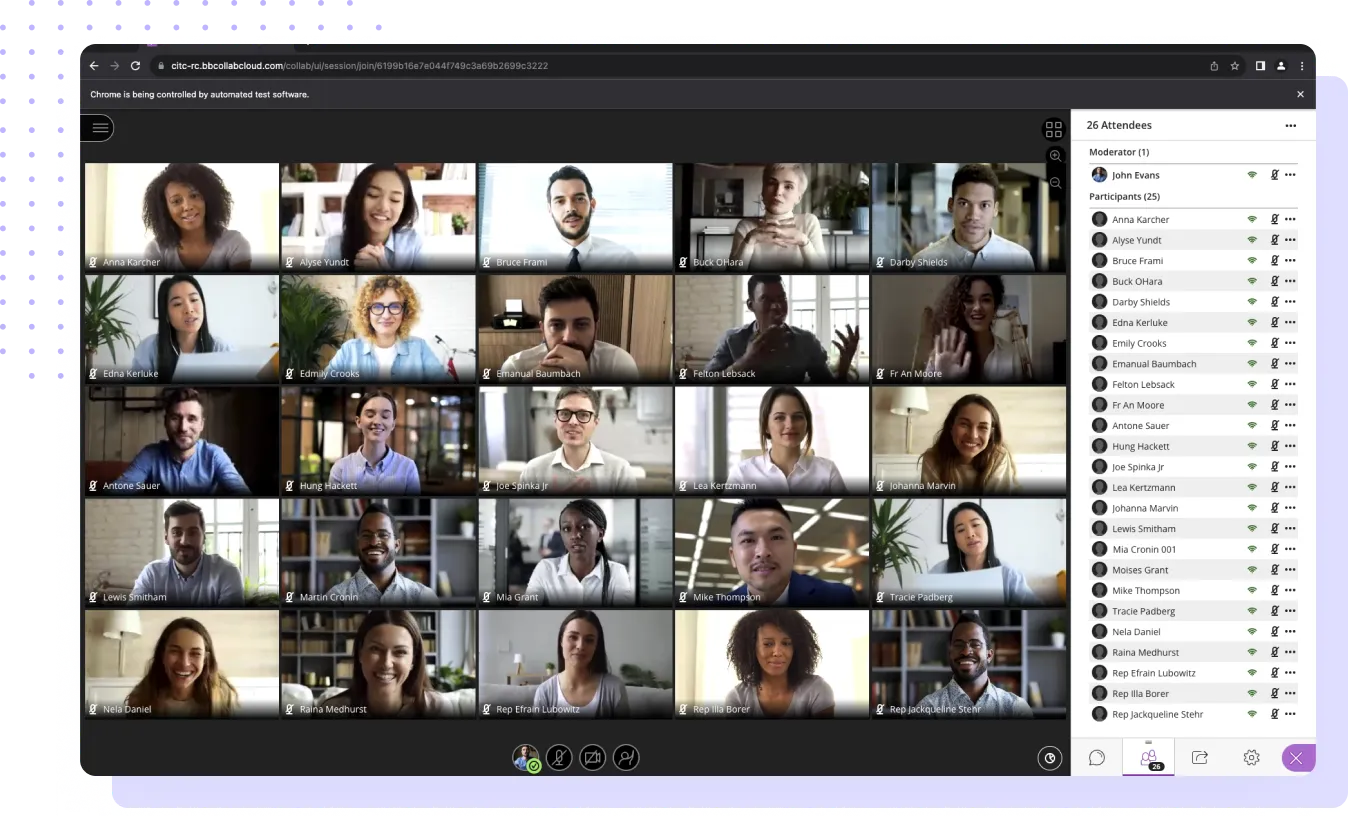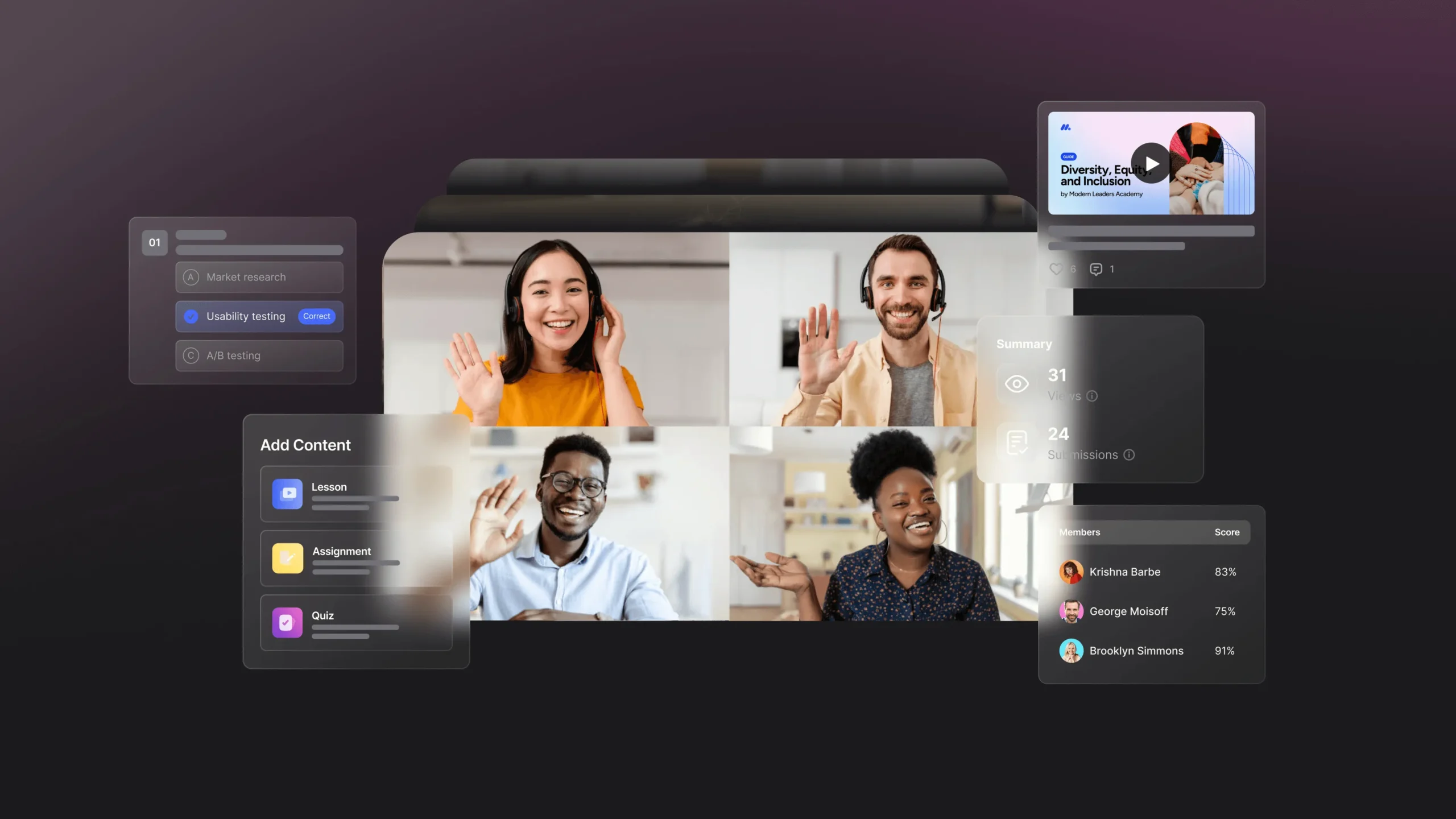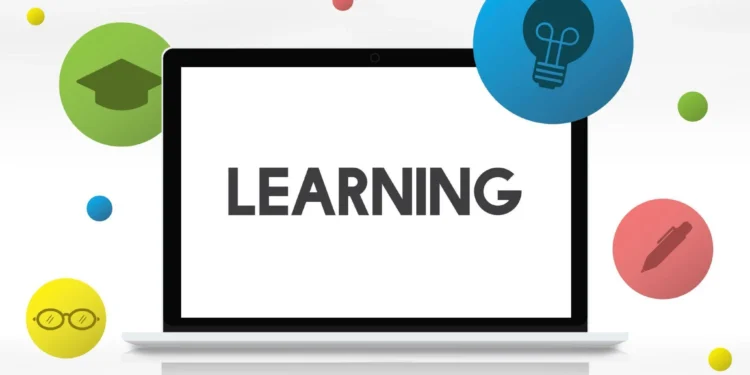In the modern educational landscape, learning is no longer confined to individual effort or isolated classrooms. The rise of digital technology and global connectivity has given birth to a more interactive and participatory learning model: online collaborative learning.
This model enables students, educators, and professionals to co-create knowledge, engage in discussions, and solve problems collectively from anywhere in the world. It promotes peer learning, critical thinking, communication skills, and a deeper understanding of subject matter through shared experiences.
Collaborative learning platforms have transformed both formal and informal education systems by offering tools for virtual classrooms, real-time discussions, co-authoring documents, group assignments, brainstorming, feedback, and project-based learning. From school classrooms to remote corporate teams, these platforms cater to diverse learning environments, unlocking the full potential of group synergy. In this comprehensive guide, we explore 60+ powerful platforms that are shaping the future of collaborative education, starting with a dedicated group of 10 essential platforms that every educator, student, or learning team should consider.

The Core Group of Online Collaborative Learning Platforms
This foundational group of ten platforms serves as the backbone of successful collaborative learning experiences. Whether you’re an educator designing group assignments, a student working on a remote group project, or a corporate trainer fostering teamwork, these platforms offer a combination of real-time collaboration, communication, content creation, and task management. What makes this group distinct is its balance between usability, scalability, and educational impact. They help create digital learning spaces where knowledge can be co-constructed, peer feedback is encouraged, and learning is socially enriched.
These platforms provide intuitive interfaces, seamless integration with productivity tools, real-time updates, and features that foster equitable participation across virtual teams. Together, they form a complete ecosystem for synchronous and asynchronous collaborative education, ensuring learners stay engaged and connected regardless of their geographical location.
1. Google Workspace for Education
Formerly known as G Suite, Google Workspace includes tools like Google Docs, Sheets, Slides, and Google Meet that support real-time collaboration. Students can work on documents simultaneously, leave comments, and communicate via chat or video.
2. Microsoft Teams for Education
Combining chat, video conferencing, and collaborative file sharing, Microsoft Teams is tailored for educational settings. It supports class channels, assignments, quizzes, and document co-editing—ideal for school and university collaboration.
3. Zoom with Breakout Rooms
While Zoom is primarily a video conferencing tool, its breakout rooms, chat, and whiteboard features make it a versatile platform for group learning sessions, workshops, and collaborative discussions.
4. Slack
Slack is a powerful communication platform for educational and professional groups. With channels, threads, file sharing, and app integrations, it supports collaborative projects and knowledge exchange.
5. Padlet
Padlet allows users to collaboratively post text, images, videos, and links on a shared digital board. It’s widely used in classrooms for brainstorming, project planning, and visual collaboration.
6. Miro
Miro is a digital whiteboard that supports sticky notes, mind maps, flowcharts, and templates. It’s ideal for brainstorming sessions, visual learning, and team-based planning in both education and business.
7. Edmodo
Edmodo provides a social learning environment where teachers and students can share resources, quizzes, and discussions. It functions like an educational Facebook, fostering interaction and collaboration.
8. Trello
Originally designed for task management, Trello is now widely used in education for organizing projects, assigning tasks, and visualizing workflow using boards, lists, and cards.
9. Notion
Notion offers a flexible workspace combining notes, databases, task lists, and calendars. It’s used in group learning settings for collaborative research, content management, and real-time documentation.
10. Canvas LMS
Canvas is a comprehensive learning management system that includes tools for discussion boards, group assignments, document sharing, and integrated third-party apps to support collaborative instruction.

Project Management and Group Coordination Platforms Group
In collaborative learning, especially in academic or professional settings, managing tasks, tracking progress, and ensuring accountability are just as important as content creation. This group of platforms is focused on project coordination—providing tools to help learners assign responsibilities, visualize deadlines, and monitor project workflows in real time. These tools are not traditional learning platforms but serve a vital educational function: teaching students how to organize their work, collaborate efficiently, and meet deliverables as a team. By simulating real-world project environments, these platforms also prepare students for teamwork in professional settings, making them especially useful in capstone projects, group research, business simulations, and cross-functional learning initiatives.
11. Asana
Asana is a task and project management platform that helps teams plan, organize, and track collaborative work. In education, it’s used for multi-phase assignments, team-based learning, and project submissions.
12. Monday.com
Monday.com provides visual project boards and templates that make it easy for students and educators to manage assignments, deadlines, and collaborative workflows. It’s intuitive and scalable for both small teams and class-wide projects.
13. Basecamp
Known for its simplicity, Basecamp combines messaging, task assignments, file storage, and scheduling. It promotes asynchronous collaboration and is great for remote study groups or project teams.
14. ClickUp
ClickUp allows students and teachers to plan, track, and collaborate on tasks with to-do lists, calendars, and Gantt charts. It’s especially effective in courses involving ongoing project development.
15. Airtable
Airtable blends the simplicity of a spreadsheet with the functionality of a database. It’s excellent for organizing group research, managing content for class publications, or tracking peer-reviewed assignments.
16. Teamwork
Originally designed for agency and client collaboration, Teamwork is adaptable for academic group projects that require milestone tracking and document sharing in a structured environment.
17. Freedcamp
Freedcamp is a free collaboration tool that supports task lists, calendars, milestones, and file storage. It’s a lightweight option for student groups managing shared responsibilities.
18. Quire
Quire is a sleek task management tool ideal for collaborative brainstorming and agile project development. Its nested task lists are especially useful in academic settings with complex assignment hierarchies.
19. Taskade
Taskade combines outlining, task management, and video chat into one app. Its real-time collaboration features are useful for study sessions, team-based writing, and agile classroom projects.
20. MeisterTask
With a strong visual workflow, MeisterTask helps students manage tasks in a Kanban-style interface. It’s great for group activities requiring brainstorming, planning, and iterative review.

Interactive Content Sharing and Peer Learning Platforms Group
In collaborative education, engagement and participation are the lifeblood of meaningful learning. This group of platforms emphasizes interactive content delivery, peer feedback, and social learning dynamics. Unlike traditional one-way content dissemination, these platforms facilitate a two-way or multi-directional interaction—allowing learners to co-create content, evaluate each other’s work, and engage in continuous discourse. These platforms support live annotation, peer grading, collaborative multimedia sharing, and structured discussion forums that mimic or even improve upon in-person classroom dialogue. They are ideal for fostering a sense of community, enabling peer review, and making learning a socially enriching experience. They also support constructivist teaching strategies, where knowledge is actively built through interaction, instead of passively received.
21. Flip (formerly Flipgrid)
Flip is a video discussion platform where educators can pose questions and students respond with short videos. It enhances peer-to-peer interaction, especially in language learning and reflective assignments.
22. Wakelet
Wakelet allows users to curate content collections—articles, videos, notes, and more—and share them with peers. Students use it for collaborative research projects, digital storytelling, or resource repositories.
23. VoiceThread
VoiceThread enables collaborative conversations around images, videos, and documents using audio, video, and text commentary. It is highly effective for interactive presentations and feedback sessions.
24. Nearpod
Nearpod allows teachers to create interactive lessons that include quizzes, polls, collaborative boards, and VR experiences. Students can engage and respond in real-time or asynchronously.
25. Peergrade
A peer review tool designed for educational use, Peergrade enables students to evaluate each other’s work based on teacher-created rubrics, encouraging critical thinking and feedback literacy.
26. Edpuzzle
Edpuzzle turns passive videos into interactive lessons with embedded questions and commentary. It supports accountability in video learning and promotes engagement with course material.
27. Sutori
Sutori is a storytelling tool for education that helps students and teachers create collaborative timelines, presentations, and multimedia stories, perfect for history and language arts projects.
28. Kialo Edu
A structured debate platform where students collaboratively build argument maps. It’s ideal for teaching critical thinking, discussion skills, and evidence-based reasoning.
29. Goosechase
Goosechase is a platform for interactive scavenger hunts and collaborative learning games. It’s popular for project-based learning, orientation sessions, and team-building activities.
30. Parlay
Parlay is designed to promote discussion-based learning. It allows students to engage in written or live discussions, reflect on peers’ responses, and track participation and insight depth.

Learning Management Systems (LMSs) and Virtual Classroom Platforms Group
Learning Management Systems (LMSs) serve as the central hub for delivering, tracking, and managing online educational content. In collaborative learning environments, LMSs not only streamline course delivery but also enable robust communication, group assignments, peer assessments, discussion boards, and third-party tool integrations. Virtual classroom tools built into or alongside LMSs provide real-time interaction, making it synchronously easier for students to engage with instructors and classmates. These platforms promote a structured learning journey, supporting blended, hybrid, and fully online courses that rely on active collaboration and personalized feedback loops.
31. Moodle
Moodle is a widely-used open-source LMS that supports forums, quizzes, group activities, and plugins for collaborative projects. It’s popular in higher education and customizable to institutional needs.
32. Blackboard Learn
Blackboard combines course delivery, assessment, collaboration, and communication tools. Its group features, discussion boards, and built-in video conferencing enable structured peer interaction.
33. Schoology
A user-friendly LMS that supports collaboration through groups, discussion threads, shared resources, and group-based assignments. It’s ideal for K–12 and higher education alike.
34. Brightspace (D2L)
Brightspace offers adaptive learning paths, multimedia content, and collaborative discussion features. It’s excellent for institutions focused on accessibility and personalized learning.
35. BigBlueButton
This open-source virtual classroom platform integrates with most LMSs and includes breakout rooms, shared notes, polling, and live whiteboards for real-time collaborative learning.
36. ClassDojo
Popular in elementary education, ClassDojo connects teachers, students, and parents. It allows teachers to assign collaborative tasks, share updates, and track student progress.
37. TalentLMS
Designed for corporate training and eLearning, TalentLMS supports multimedia content, collaborative projects, and gamification elements. It works well for blended team training programs.
38. WizIQ
WizIQ provides virtual classrooms, online courses, and assessments. Its features include breakout rooms, collaborative whiteboards, and content co-creation.
39. LearnWorlds
A platform for creating, selling, and managing online courses. It includes collaborative elements like quizzes, assignments, and interactive video discussions.
40. Thinkific
Primarily an online course platform, Thinkific allows instructors to organize learners into groups, host live events, and foster peer interactions within structured modules.

Academic Research and Co-Authoring Platforms Group
Academic collaboration has grown increasingly digital, with students and researchers now co-authoring papers, conducting group analysis, and sharing findings through web-based tools. This group focuses on platforms that enable collaborative writing, data sharing, and research discussion. These tools not only enhance transparency and peer input but also build critical academic skills like citation, summarization, and scholarly dialogue. For both students and professionals, these platforms streamline the workflow of writing and publishing high-quality academic content.
41. Overleaf
Overleaf is a collaborative LaTeX editor, ideal for academic papers, theses, and research projects. It offers real-time co-authoring and formatting for complex scientific documents.
42. Authorea
Authorea combines WYSIWYG and LaTeX editing for collaborative academic writing. It supports version control, citation management, and publisher-ready formatting.
43. Paperpile
Paperpile is a reference and citation manager built for Google Docs. It supports real-time collaboration, making it perfect for co-authored research projects.
44. ResearchGate
While primarily a networking platform, ResearchGate supports academic collaboration by allowing researchers to share preprints, data, and feedback with peers.
45. Academia.edu
Academia.edu allows researchers and students to upload, share, and collaborate on academic work. Discussion threads and article feedback foster scholarly interaction.
46. Sciwheel
Formerly F1000Workspace, Sciwheel offers collaborative referencing, note-taking, and co-authoring features for research teams and university labs.
47. Mendeley (Extended Use)
In addition to being a citation tool, Mendeley supports private collaboration groups for sharing research and annotating documents together.
48. Zotero Groups
A feature within Zotero that allows researchers to create collaborative libraries where members can annotate, organize, and cite sources together.
49. Google Docs for Research
Google Docs remains a top choice for collaborative academic writing, offering simultaneous editing, comment threads, and easy integration with citation tools.
50. Notion for Research Collaboration
Notion helps academic teams organize literature reviews, share notes, build bibliographies, and plan publications—all in a flexible workspace.

Creative Collaboration and Multimedia Learning Platforms Group
Not all learning happens through traditional text-based methods. Visual, audio, and multimedia tools are critical for learners who thrive through creativity and non-linear thinking. This group features platforms that support collaborative creativity, allowing students to co-design presentations, edit videos, record podcasts, or storyboard narratives. These tools are crucial in media education, digital storytelling, project-based learning, and STEAM disciplines. They help students develop 21st-century skills in digital literacy, collaboration, and multimedia communication.
51. Canva for Education
Canva enables students to co-create infographics, presentations, posters, and reports. Real-time collaboration makes it a powerful tool for visual learning projects.
52. Adobe Express
Formerly Adobe Spark, this platform allows for collaborative creation of videos, graphics, and web pages. Ideal for group storytelling or media-based assignments.
53. Prezi
Prezi allows students to build dynamic, collaborative presentations. Its zoomable canvas supports non-linear storytelling and brainstorming for group projects.
54. Animoto
Animoto enables teams to collaborate on short-form educational videos. It’s used in marketing, digital media, and student showcase presentations.
55. WeVideo
A cloud-based video editor with collaborative timelines, perfect for joint storytelling, video resumes, and digital classroom documentaries.
56. Book Creator
Students can co-author digital books by embedding text, video, and audio. It’s widely used for collaborative story writing, especially in K–12 environments.
57. Soundtrap by Spotify
This online studio allows students to collaboratively produce music, podcasts, and audio projects. Great for media arts and group audio experiments.
58. Pixton
Pixton lets students create comic strips collaboratively, enhancing storytelling skills in an engaging and visual format. Great for narrative projects and ESL classrooms.
59. Adobe Creative Cloud (Team Use)
A suite of industry-standard tools that supports collaborative design, video editing, and multimedia content creation, often used in higher education and creative programs.
60. Figma
A collaborative UI/UX design tool also used in educational environments to create wireframes, prototypes, and digital portfolios with live collaboration features.

Hybrid Learning and Blended Collaboration Tools Group
With the rise of hybrid learning models, where online and in-person education co-exist, it’s essential to have platforms that blend synchronous and asynchronous collaboration seamlessly. This final group includes tools that help facilitate blended environments through real-time interaction, asynchronous assignments, feedback mechanisms, and adaptive learning paths. These tools are critical for maintaining learner engagement, equitable access, and flexibility in classrooms that may be partially or fully remote. They support flipped classrooms, project-based learning, and mixed-media content delivery—perfect for educators embracing modern pedagogies.
61. Kami
Kami allows students to annotate PDFs and documents in real time. It supports collaborative editing, audio/video comments, and live feedback—ideal for hybrid classrooms.
62. Pear Deck
Pear Deck turns Google Slides into interactive presentations with real-time student responses. It supports synchronous and asynchronous modes and fosters group engagement.
63. Classkick
This platform lets teachers see student progress in real time and give feedback instantly. Students can also help peers, promoting collaborative learning within assignments.
64. Explain Everything
A collaborative whiteboard tool for creating explainer videos, brainstorming diagrams, and interactive lessons. Ideal for hybrid and flipped classrooms.
65. Formative
Formative enables live assessments where teachers can give feedback as students respond. Its collaborative features encourage peer support and co-assessment.
66. Seesaw
Used in K–12, Seesaw enables students to document and share learning portfolios. Families, teachers, and classmates can interact with posts, promoting transparent collaboration.
67. Classcraft
A gamified classroom platform where students collaborate to complete learning quests. It supports team-based engagement, especially for middle and high school learners.
68. Microsoft Whiteboard
A collaborative drawing and brainstorming tool integrated into Microsoft Teams. Students can co-create diagrams, concept maps, and problem-solving sketches.
69. Jamboard by Google
Google’s digital whiteboard lets students and teachers collaborate on drawings, timelines, storyboards, and annotations—great for brainstorming and visual learning.
70. Loopy
Loopy helps learners visualize systems thinking through collaborative concept maps. Ideal for science, economics, and systems design projects.

In a world where digital learning is not just a supplement but a necessity, collaborative learning platforms have redefined the educational experience. These 70+ platforms span every corner of the learning spectrum—from brainstorming and project planning to video conferencing, content creation, real-time feedback, and interactive classroom experiences. They empower students and educators alike to transcend geographical barriers, enabling richer discussions, greater peer-to-peer support, and interactive knowledge construction.
The initial group of essential platforms provides a robust foundation for any learning environment looking to enhance cooperation and engagement. But as this list expands into tools designed for task management, academic writing, media creation, and hybrid classrooms, it becomes clear that the potential for collaboration is both vast and adaptable to any context—academic, corporate, creative, or vocational.
Ultimately, the success of collaborative learning hinges on the tools we choose to support it. Integrating the right platforms into your teaching or training strategy allows you to foster environments where every learner feels heard, supported, and empowered to contribute. These platforms are more than just software—they’re catalysts for curiosity, inclusion, and lifelong learning.










